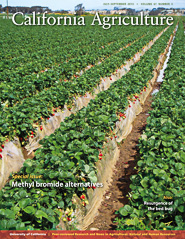All Issues

Special issue: Methyl bromide alternatives
Cover:
Growers have long used methyl bromide to essentially sterilize soil, but this fumigant is being phased out due to environmental and health concerns. New research helps identify methyl bromide alternatives to control pathogens, pests and weeds in strawberries (p 139), almonds and stone fruits (p 128), forest nurseries (p 153) and perennial nursery crop stock (p 181), and shows that multi-layer tarps reduce fumigant emissions (p 147). This work is part of the Pacific-Area Wide Integrated Methyl Bromide Alternatives Program, a USDA-funded collaboration of UC and USDA researchers. Shown is a strawberry field in coastal southern California, a region where fumigants are restricted to protect people’s health. Photo by Janet Hudson
July-September 2013
Volume 67, Number 3
Volume 67, Number 3





